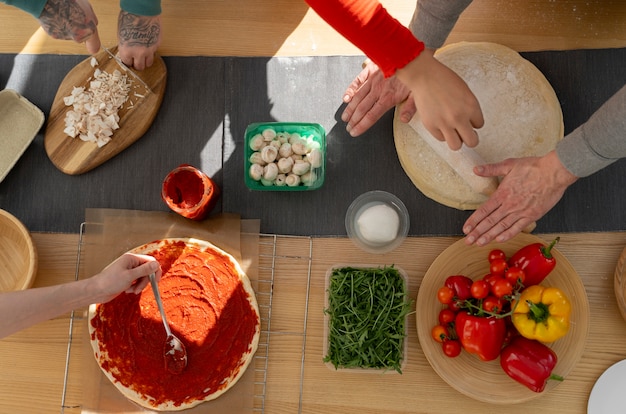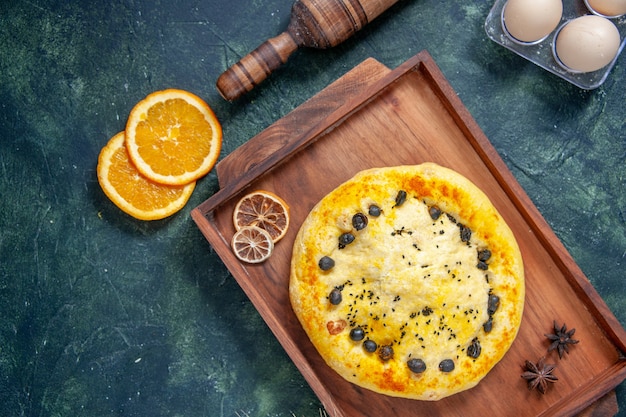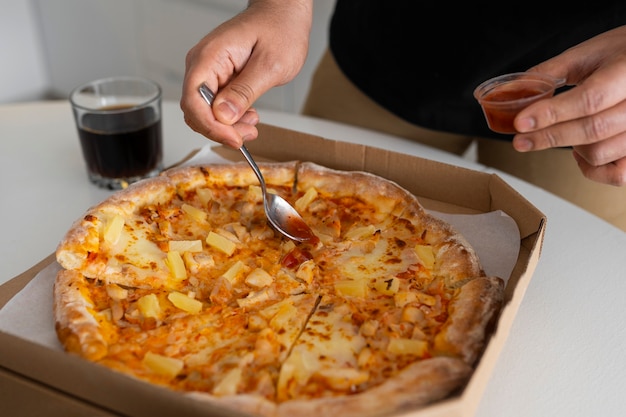Let's be honest, quiche has a bit of a fancy reputation. It's often associated with elegant brunches and sophisticated gatherings, making it seem like a dish only for experienced cooks. But I'm here to tell you, quiche is actually quite approachable! It's incredibly versatile, adaptable to any flavour preference, and, more importantly, a lot easier to make than you might think. Think of it as a comforting, familiar dish that can be dressed up for special occasions or enjoyed casually at home.
I've been making quiche for years, and let me tell you, it's one of those recipes that always impresses. I've learned a few tricks along the way, and I'm excited to share them with you. This guide is your ultimate resource, covering everything from crafting a perfect crust to mastering the art of filling it with flavour. So, grab your apron, gather your ingredients, and let's embark on a quiche-making adventure together!
(Part 1) The Crust: The Foundation of a Delicious Quiche

The crust is the foundation of any great quiche, the canvas on which your culinary masterpiece is built. While you can certainly opt for a pre-made crust, I find the satisfaction of making your own dough is well worth the effort. It's surprisingly simple, and the result is a beautifully flaky and flavourful crust that elevates the entire dish. No need for fancy flour blends or exotic ingredients, just a classic combination of flour, butter, and a touch of salt. Trust me, it's a foolproof recipe, even if you're a baking beginner.
The Art of Dough Chilling
One of the secrets to a fantastic crust is chilling. Yes, it's an extra step, but trust me, it's crucial. Chilling allows the butter to solidify, which translates to a flaky, tender crust that doesn't crumble easily. Once you've chilled your dough, gently roll it out on a lightly floured surface, ensuring it's slightly larger than your pie pan.
blind baking: A Crucial Step
My grandmother taught me the importance of blind baking the crust. This involves baking the crust before adding the filling, which prevents it from becoming soggy and ensures a perfectly crisp base. Line the crust with parchment paper, weigh it down with baking beans (or use dried beans!), and bake it for 15-20 minutes.
Choosing the Right Pie Pan
When it comes to pie pans, I recommend a deeper, non-stick tart pan. It gives your quiche more room to rise and makes it a breeze to remove once it's cooked. You can use a standard pie dish, but the extra depth of a tart pan is a personal preference.
(Part 2) The Filling: A World of Possibilities

Here's where your creativity really shines! quiche fillings are endlessly adaptable, allowing you to tailor your dish to your taste buds and what's in your fridge. The core ingredients are eggs, milk or cream, and cheese. But from there, the sky's the limit!
A Classic Quiche Lorraine: A Time-Honoured Favourite
If you're looking for a classic, Quiche Lorraine is a timeless choice. It's a symphony of bacon, Gruyere cheese, and, of course, eggs and cream. It's a crowd-pleaser, perfect for a weekend brunch or a light lunch.
Veggie Delights: A Lighter Option
For a lighter, healthier option, a veggie quiche is a fantastic choice. Imagine spinach, mushrooms, bell peppers, onions – the possibilities are endless! Just remember to sauté your vegetables before adding them to the egg mixture, which helps them cook evenly and prevents them from making the quiche soggy.
Get Creative: Unleashing your Flavour Inspiration
Don't be afraid to step outside the box! Add smoked salmon for a touch of luxury, chorizo for a spicy kick, or leftover roast chicken for a hearty meal. Quiche is an excellent way to use up leftovers and create something delicious.
(Part 3) Baking Time: The 350 Degrees Fahrenheit Secret

The beauty of baking a quiche is its simplicity. My go-to temperature is 350 degrees Fahrenheit. No need to complicate things with different oven temperatures; this one consistent temperature will ensure a perfectly cooked quiche every time.
The Timing Game: A Little Trial and Error
Now, the baking time depends on the size of your quiche and how much filling it contains. For a standard 9-inch quiche, I recommend 45-50 minutes. However, the best way to know when it's done is the tried-and-true jiggle test.
When your quiche is done, it should have a slightly wobbly centre and a golden brown top. If you're unsure, give it a gentle poke with a toothpick. If it comes out clean, it's ready to enjoy.
(Part 4) Cooling and Serving: The Finishing Touches
Your quiche is out of the oven, looking all golden and glorious! But don't dive in just yet! Allow it to cool down for 10-15 minutes. This helps the filling set properly and prevents it from spilling when you cut into it.
A Feast for the Senses
Now, how to serve this masterpiece? The possibilities are endless! A classic green salad is a fantastic accompaniment, but you can also opt for a more substantial side dish like roasted vegetables, potato salad, or a simple pasta salad. And don't forget about the bread! A crusty baguette or sourdough slices are perfect for dipping into the creamy goodness.
(Part 5) Variations and Tips: Elevating your Quiche Game
Sometimes, you want to take your quiche to the next level, adding a bit of flair to your culinary creation. We've already explored the incredible diversity of fillings, but here are some additional tips and tricks to make your quiche truly stand out.
Flavour Boosters: Herbs and Spices
A handful of fresh herbs like thyme, rosemary, or parsley can infuse your quiche with a burst of flavour. If you're feeling adventurous, a sprinkle of nutmeg or cayenne pepper can add a subtle hint of spice and complexity to the dish.
Texture Variations: Creamy Delights
For a richer, creamier quiche, try adding crème fra??che or sour cream to the filling. It adds a tangy flavour and a luxurious texture. Experiment with different types of cheese; goat cheese, for instance, offers a more complex flavour profile than cheddar.
A Touch of Sweetness: A Surprising Twist
This might sound unusual, but a splash of sweet wine or a drizzle of honey can add a surprisingly harmonious depth of flavour to a savoury quiche. A tiny bit is all you need to balance the richness of the cheese and eggs, creating a delightful contrast.
(Part 6) Quiche Mistakes to Avoid: Lessons Learned from Experience
We've all been there – we've attempted a recipe, and it hasn't quite turned out the way we envisioned. To help you avoid common pitfalls, here are a few mistakes I've learned from (the hard way) along my quiche-making journey.
Overmixing the Dough: A Gentle Touch is Key
Overmixing your dough will result in a tough, chewy crust. A light hand is essential. Mix until the ingredients are just combined and the dough forms a ball.
Skipping the Blind Baking: A Crucial Step
Blind baking is non-negotiable! It's the secret to a perfectly crisp crust, and it prevents your quiche from becoming soggy. Don't skip this step.
Overfilling the Crust: Leaving Room for Rise
Don't cram your crust with too much filling. Leave a little space at the top to allow for the quiche to rise. Overfilling can lead to spilling and a messy oven.
Baking Too Long: Preventing Dryness
Keep a watchful eye on your quiche while it's baking. You don't want it to become dry. If the top starts to brown excessively, cover it loosely with foil for the last few minutes of baking.
(Part 7) Leftovers: Not a Waste, a Culinary Opportunity
Leftover quiche? Don't despair! It's a delicious way to enjoy a second meal or even a snack.
Keeping Leftovers Fresh
Store leftover quiche in the refrigerator in an airtight container. It should stay fresh for a few days, making it perfect for a quick lunch or snack.
Creative Leftover Transformations: Beyond the Ordinary
Now, here's where leftover quiche gets interesting. You can use it to create entirely new dishes! Cut it into cubes and toss it with a salad, or add it to a soup or pasta dish. It adds a lovely texture and flavour to any dish.
(Part 8) Beyond Quiche: Exploring Other Egg-cellent Delights
Eggs are incredibly versatile, and if you're reading this, you probably share my love for them! So let's step beyond quiche for a moment and explore other egg-cellent dishes that are sure to please your palate.
Omelettes: A Quick and Easy Favourite
Omelettes are a quick and easy breakfast or lunch option. Add in anything you like, from vegetables and cheese to meats and herbs.
Eggs Benedict: A Decadent Brunch Staple
For a luxurious brunch, try Eggs Benedict. It's a classic combination of poached eggs, hollandaise sauce, and english muffins.
Frittatas: Similar but Different
Frittatas are similar to quiches but are often baked in a skillet instead of a pie pan. They're a fantastic way to use up leftover vegetables and meats.
(Part 9) FAQs: Your Quiche Questions Answered
1. Can I freeze quiche?
Absolutely! Freeze your quiche in an airtight container or wrap it tightly in plastic wrap. It will last for up to 3 months in the freezer. To reheat, thaw it overnight in the refrigerator and then bake it in a preheated oven at 350 degrees Fahrenheit for 20-25 minutes.
2. Can I use different types of cheese?
Yes, absolutely! Experiment with your favourite cheeses. Keep in mind that some melt better than others. Gruyere and cheddar are reliable melters, while some soft cheeses may not hold their shape as well.
3. Can I make quiche ahead of time?
Absolutely! You can assemble your quiche up to a day ahead of time and refrigerate it. When you're ready to bake it, take it out of the refrigerator and let it sit at room temperature for 30 minutes before baking.
4. What if my crust is too soggy?
If your crust is soggy, bake it for a few more minutes to crisp it up. You can also sprinkle a bit of breadcrumbs on the bottom of the crust before baking to help absorb any excess moisture.
5. What if my quiche doesn’t set properly?
If your quiche is still runny after baking, it might not have been cooked long enough. Return it to the oven and bake it for another 5-10 minutes. You can also try adding a little more egg to the filling next time to help it set more firmly.
There you have it, a comprehensive guide to baking a delicious quiche. Go forth, conquer your kitchen, and remember, the most important ingredient is enjoying the process. Happy baking!
Everyone is watching

Perfect Rice Every Time: The Ultimate Guide to Cooking Rice
Cooking TipsAs a self-proclaimed foodie, I've always been a bit obsessed with rice. It's the foundation of countless cuisi...

Prime Rib Roast Cooking Time Chart: Per Pound Guide
Cooking TipsPrime rib roast. Just the name conjures images of lavish dinners, crackling fires, and hearty laughter. It’s ...

The Ultimate Guide to Cooking Asparagus: Tips, Techniques, and Recipes
Cooking TipsAsparagus. The mere mention of this spring delicacy conjures up images of vibrant green spears, crisp and burs...

Ultimate Guide to Cooking the Perfect Thanksgiving Turkey
Cooking TipsThanksgiving. Just the word conjures up images of overflowing tables laden with delicious food, the scent of r...

How Long to Bake Potatoes in the Oven (Perfect Every Time)
Cooking TipsBaked potatoes are a staple in my kitchen. They're incredibly versatile, delicious, and surprisingly easy to m...
